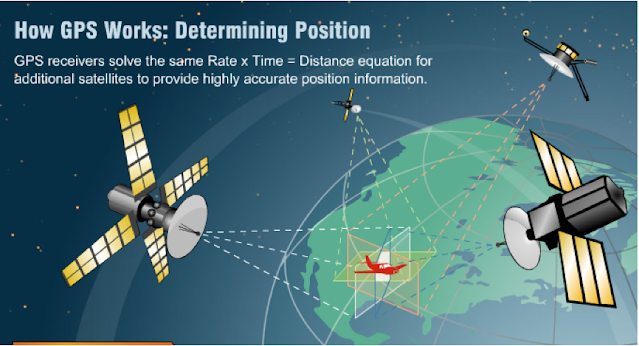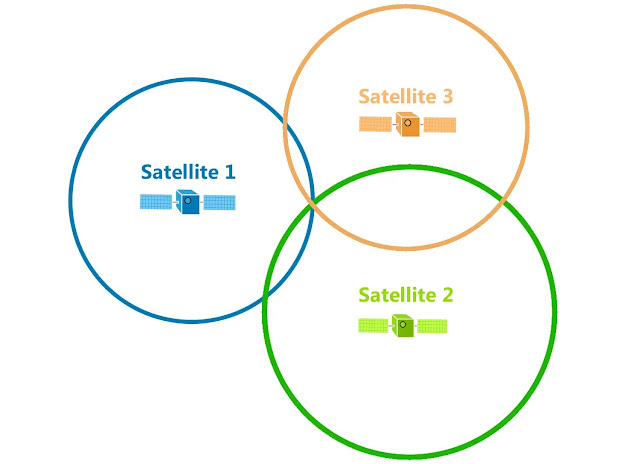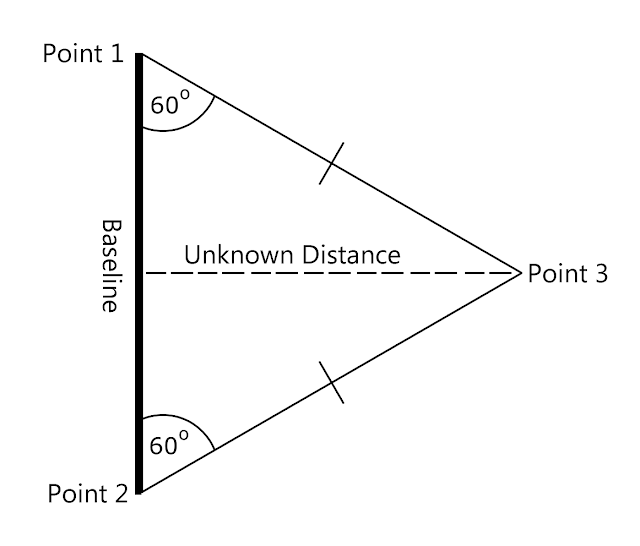GPS (Global Positioning System) is a satellite-based route framework. It gives general setting-based data to a GPS collector, found anyplace on or close to the world's surface. GPS works in every climate condition if there is an unobstructed line correspondence with at least 4 GPS satellites. GPS is overseen by the US Air Force.
A GPS works freely of the client's web association or phone signal. Notwithstanding, their quality expands the adequacy of GPS situating. GPS was at first evolved by the US government for military purposes, however, right now, anybody with a GPS recipient can get radio transmissions from GPS satellites.
Note:
- At first, when GPS was produced for military use, there were 24 GPS satellites circling the earth at regular intervals at a tallness of 20, 180 km.
- 4 GPS satellites were situated in every one of the 6 circles with a 60-degree direction between one another. These orbital planes don't pivot regarding any star.
- Afterward, the number of satellites was expanded to 32, to further develop area precision.
- Restriction of any GPS beneficiary is done through a period of flight estimation.
- The more noteworthy the quantity of satellites in view to a GPS beneficiary, the more prominent is the exactness in deciding the place of the collector.
How does GPS function?
At any moment of time, there are no less than 4 GPS satellites in view to a recipient on the earth. Every one of these GPS satellites sends data about its position and the current chance to the GPS beneficiary at fixed normal moments of time. This data is communicated to the recipient as a sign which is then caught by the collector gadgets. These transmissions are radio transmissions that movement with the speed of light. The distance between a GPS beneficiary and the satellite is determined by observing the contrast between the time the sign was sent from the GPS satellite and the time the GPS collector got the sign.
When the collector gets the sign from somewhere around three satellites, the recipient then, at that point, focuses its area utilizing the trilateration cycle. A GPS expects no less than 3 satellites to work out a 2-D position(latitude and longitude on a guide). For this situation, the GPS recipient accepts that it is situated at mean ocean level. Notwithstanding, it expects something like 4 satellites to find the recipient's three-dimensional position(latitude, longitude, and elevation).
 |
| GPS Working |
 |
| GPS Works |
Trilateration is the process of determining your position based on the intersection of spheres. When a receiver receives a signal from one of the satellites, it calculates its distance from the satellite considering a three-dimensional circle with the satellite situated at the focal point of the circle. When the recipient does likewise with 3 different GPS satellites, the collector then, at that point, continues to observe the convergence point of the 3 circles to work out its area.
Once the position of a receiver is calculated, the GPS device can then easily calculate:
- Time of sunrise and sunset
- Speed
- Track
- distance to destination
of the GPS recipient.
 |
| Trilateration |
 |
| Triangulation |
Technical challenges faced by GPS:
- Time synchronization between individual satellites and the GPS receiver
- Real-time update of the exact location of the GPS satellite
- Precise measurement of time of flight
- Interference with other signals
Time synchronization:
Every one of the GPS satellites is furnished with a nuclear clock to keep the time refreshed and exact. To refresh and give exact planning on the recipient, the collector utilizes the fourth GPS satellite to keep its planning precise. With the circumstance with the collector and GPS satellites kept up with by nuclear timekeepers, the specific time contrast can be determined by the beneficiary.
The GPS satellites are continually overseen from ground-based stations to determine time synchronization.
Significance of ultra-accuracy of time synchronization:
Electromagnetic radiation propagates with the speed of light. The accuracy in position is directly proportional to the time measurement, as speed * time = distance, consequently, even a slight deviation in time computation can make an enormous distinction in distance because of the huge speed of light.
Real-time update of the exact location of the satellite:
- This is finished by observing the satellites from various generally appropriated ground-based frameworks.
- The expert station examinations every one of the estimations and sends the real place of each satellite.
Differential GPS [DGPS]:
DGPS is an improvement over GPS that gives upgraded area precision
Working:
DGPS is an improvement over GPS that provides enhanced location accuracy
Working:
- The GPS receiver also called the base station must be set up at a precisely known location
- The base station receiver calculates its position based on the satellite signals and compares its location to the known location
- The difference between the two locations is applied to the data recorded by the GPS receiver
- Provides position accuracy in sub-meter to cm range
DGPS utilizes an organization of fixed ground-based stations to communicate the contrast between the positions demonstrated by the GPS satellite frameworks and the known fixed positions. These stations broadcast the distinction between the deliberate satellite pseudo-ranges and real pseudo-ranges and the collector stations might address their pseudo-ranges by a similar sum.
GNSS: Global Navigation Satellite System
The term GPS is now so familiar to the general public that it has become synonymous with any satellite navigation system—but we need to be careful. The term GPS is actually the name of the system created by the American military and stands for Global Positioning System. There are other systems too. The Russian military system for example is called GLONASS (Global Orbiting Navigation Satellite System), while China has developed a system called BeiDou-2.
When talking about satellite navigation systems, a term you will often encounter is GNSS, which stands for Global Navigation Satellite System. This is the generic name used to describe any global system of satellites that transmit signals for navigation purposes on Earth. The distinction of using terms like GPS or GLONASS is important if you’re using satellite systems for measurement purposes because each system works in a slightly different way.
Global Positioning System (United States)
GLONASS (Russia)
Global Navigation Satellite System or GLONASS is a global navigation system of Russia. GLONASS became operational in the year 1993 with 12 satellites in 2 orbits at the height of 19,130 km. At present, there are total 27 satellites in orbit and all are operational. GLONASS is operated by Russian Aerospace Defence Forces and is the second alternative navigational system in operation.
Galileo(European Union)
Galileo is European Union’s GNSS constellation, which is being put together by the European Space Agency, and the European GNSS Agency will operate it. Galileo is a global navigation system available for civilian and commercial use. The fully deployed Galileo system will consist of 30 operational satellites and 6 in-orbit spares. As of now 22 out of 30 satellites are in orbit. Galileo started offering Early Operational Capability in 2016 and is expected to reach full operational capability by 2020.
BeiDou (China)
BeiDou is a Satellite Navigation System of China. It has a total of 22 Operational satellites in orbit and the full constellation is scheduled to comprise 35 satellites. BeiDou has two separate constellations, BeiDou-1 and BeiDou-2. BeiDou-1 also known as the first generation was a constellation of three satellites. It became operational in the year 2000 and offered limited coverage and navigation services, mainly for users in China and neighboring regions. Beidou-1 was decommissioned at the end of 2012.
 |
| GNSS of different countries |
BeiDou-2, also known as COMPASS, is the second generation of the system. It became operational in the year 2011 with a partial constellation of 10 satellites in the orbit. Next-generation of it is BeiDou-3. The first BDS-3 satellite was launched in March 2015. As of January 2018, nine BDS-3 satellites have been launched. BeiDou-3 is expected to be fully functional by the end of 2020
QZSS (Japan)
The Quasi-Zenith Satellite System is the regional satellite navigation system from Japan that is still under construction by the Satellite Positioning Research and Application Center, Japan. As per plans, the QZSS constellation will have 7 satellites, out of which 4 are already in orbit. QZSS is expected to be operational by the end of 2018, where it will provide highly precise and stable positioning services in the Asia-Oceania region. QZSS will be compatible with GPS.
IRNSS ― NAVIC (India)
The Indian Regional Navigation Satellite System (IRNSS), which was later given the operational name of NAVIC or NAVigation with Indian Constellation, is the regional satellite navigation system of India. Launched and operated by the Indian Space Research Organization (ISRO), IRNSS covers India and nearby regions extending up to 1,500 km. All the seven satellites are in orbit, but the first satellite – IRNSS A – is not functioning now since some time last year ISRO reported that all three atomic clocks on it have failed.
ISRO’s bid to launch a replacement satellite failed in August 2017 when in a rare occurrence the heat shield of the launch vehicle failed to separate to release the satellite. Currently, three IRNSS satellites of it are in the geostationary orbit and the other 4 are in geosynchronous orbits. There is still some time before India starts getting its services.

Comments